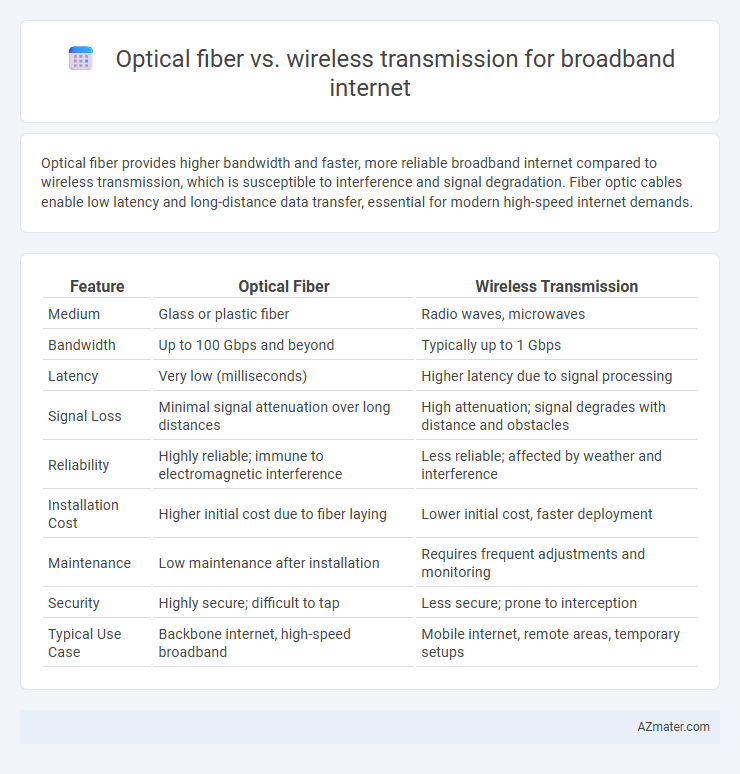Optical fiber provides higher bandwidth and faster, more reliable broadband internet compared to wireless transmission, which is susceptible to interference and signal degradation. Fiber optic cables enable low latency and long-distance data transfer, essential for modern high-speed internet demands.
Table of Comparison
| Feature | Optical Fiber | Wireless Transmission |
|---|---|---|
| Medium | Glass or plastic fiber | Radio waves, microwaves |
| Bandwidth | Up to 100 Gbps and beyond | Typically up to 1 Gbps |
| Latency | Very low (milliseconds) | Higher latency due to signal processing |
| Signal Loss | Minimal signal attenuation over long distances | High attenuation; signal degrades with distance and obstacles |
| Reliability | Highly reliable; immune to electromagnetic interference | Less reliable; affected by weather and interference |
| Installation Cost | Higher initial cost due to fiber laying | Lower initial cost, faster deployment |
| Maintenance | Low maintenance after installation | Requires frequent adjustments and monitoring |
| Security | Highly secure; difficult to tap | Less secure; prone to interception |
| Typical Use Case | Backbone internet, high-speed broadband | Mobile internet, remote areas, temporary setups |
Introduction to Broadband Internet Technologies
Broadband internet technologies offer high-speed data transmission through multiple mediums, with optical fiber and wireless being two primary methods. Optical fiber provides superior bandwidth capacity and low latency by transmitting data as light pulses through glass or plastic fibers, ideal for stable connections. Wireless transmission uses radio waves to deliver internet access without physical cables, enabling mobility and easier installation but typically at lower speeds and higher latency compared to fiber optics.
Understanding Optical Fiber Transmission
Optical fiber transmission for broadband internet uses light signals through thin strands of glass or plastic, enabling extremely high data transfer speeds and minimal signal loss over long distances. This technology supports bandwidths up to terabits per second, making it ideal for heavy data requirements and stable, low-latency connections compared to wireless transmission. Optical fiber networks are less susceptible to electromagnetic interference and weather conditions, ensuring consistent and reliable performance for time-sensitive applications.
Overview of Wireless Transmission Methods
Wireless transmission methods for broadband internet include technologies such as Wi-Fi, 4G LTE, 5G, and fixed wireless access, each utilizing radio waves to deliver data without physical cables. These methods offer flexibility and mobility, making it possible to connect devices in areas where fiber optic installation is impractical or costly. Advances in wireless protocols and spectrum efficiency continue to improve bandwidth, latency, and coverage, narrowing the performance gap with optical fiber.
Speed and Bandwidth Comparison
Optical fiber transmission offers significantly higher speeds and greater bandwidth compared to wireless broadband, supporting data rates up to 1 Gbps or more with minimal latency. Wireless transmission, while more flexible and easier to deploy, is limited by interference and signal degradation, often providing speeds ranging from 100 Mbps to 1 Gbps depending on the technology and environment. Optical fiber's superior capacity and stability make it the preferred choice for high-demand applications requiring consistent, high-speed internet access.
Reliability and Signal Stability
Optical fiber transmission offers superior reliability and signal stability for broadband internet due to its immunity to electromagnetic interference and minimal signal attenuation over long distances. Wireless transmission, while flexible and easier to deploy, often experiences signal degradation from physical obstructions, weather conditions, and electromagnetic interference, leading to inconsistent performance. The inherent stability of fiber optics makes it the preferred choice for high-speed, uninterrupted broadband connectivity in critical applications.
Installation and Infrastructure Requirements
Optical fiber installation requires laying physical cables underground or along poles, demanding extensive infrastructure development, permits, and labor-intensive trenching or aerial deployment. Wireless transmission relies on radio waves and infrastructure such as towers, antennas, and base stations, enabling faster deployment but necessitating site surveys and line-of-sight considerations. Fiber optics offer higher initial installation complexity and cost, while wireless systems provide flexible infrastructure with lower physical installation barriers, suitable for varied terrains and urban densities.
Coverage and Accessibility
Optical fiber delivers extensive broadband coverage with high-speed and low-latency connections, especially in urban and densely populated areas, but its accessibility is limited by installation costs and physical infrastructure requirements. Wireless transmission offers broader accessibility by reaching remote, rural, and hard-to-wire locations through cellular, satellite, or fixed wireless technologies, while potentially sacrificing bandwidth and signal stability. Combining both methods enhances overall network reach, balancing optical fiber's performance strengths with wireless's flexibility and coverage capabilities.
Security and Data Privacy
Optical fiber broadband provides superior security and data privacy due to its physical nature, making it extremely difficult for attackers to tap into the fiber without detection. Wireless transmission, while convenient for mobility, is more vulnerable to interception, hacking, and signal jamming, posing higher risks for data breaches. Encryption protocols can mitigate some wireless risks, but optical fiber remains the preferred choice for secure, high-integrity internet communications.
Cost-Effectiveness and Scalability
Optical fiber offers higher cost-effectiveness for broadband internet in the long term due to its durability and low maintenance requirements, despite higher initial installation costs compared to wireless transmission. Wireless transmission provides scalable deployment with quicker rollout and flexibility in expanding coverage, yet incurs ongoing expenses for spectrum licensing and infrastructure upgrades. Fiber's scalability supports substantial bandwidth growth without significant additional investment, whereas wireless scalability can be constrained by spectrum availability and interference.
Future Trends in Broadband Internet Technologies
Optical fiber offers unparalleled data transmission speeds exceeding 1 Tbps with low latency, essential for future broadband demands driven by 8K streaming, IoT expansion, and smart city applications. Wireless transmission technologies, including 5G and emerging 6G, enable flexible, high-capacity connectivity characterized by ultra-low latency and massive device support, crucial for mobile broadband and real-time communication. Integration of optical fiber backbones with advanced wireless access points will define future broadband infrastructure, delivering seamless, high-speed internet connectivity across both urban and remote areas.

Infographic: Optical fiber vs Wireless transmission for Broadband internet
 azmater.com
azmater.com